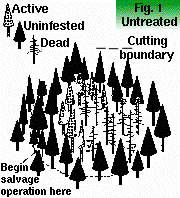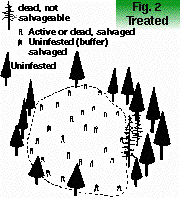- Identify all currently infested (active) trees within the spot (the most recently attacked trees in an exapanding infestation still will have green foliage as well as pitch tubes and/or boring dust in bark crevices).
- With tree-marking paint or flagging, mark the salvage boundaries to include a horseshoe-shaped buffer of green, uninfested trees around the active head of the spot (Fig. 1).

For small- to medium-sized spots (<100 infested trees), the buffer should be as wide as the average height of the trees in the spot (40 to 60 feet). A wider buffer will be needed for rapidly expanding spots that have more than 100 currently infested trees. The buffer is required to guarantee disruption of spot growth and dispersion of beetle populations from the infested area. - Salvage should begin as soon as possible after the harvesting boundaries are marked. Cut and remove trees within the buffer first to prevent further spot growth. Continue harvesting towards the spot origin until only those dead trees that have deteriorated beyond use remain standing (Fig. 2).

- Do not deck infested logs against standing green trees since odors from the logs may draw beetles to adjacent green trees. Ideally, infested trees should be removed from the woods within a few days of felling to prevent the escape of emerging beetles.
- Avoid scraping or damaging standing green trees along skid trails. Open wounds attract certain bark beetles.
- After two weeks check the treated spot for re-infestations (breakouts) around the outer edge of the spot, along skid trails or around log decking areas. Re-treat all breakouts.
The buffer strip of green trees must be included to assure effective control, particularly for spots treated during warm months. If salvage operations are delayed, active spots may have to be marked again prior to harvesting to account for additional spot growth.